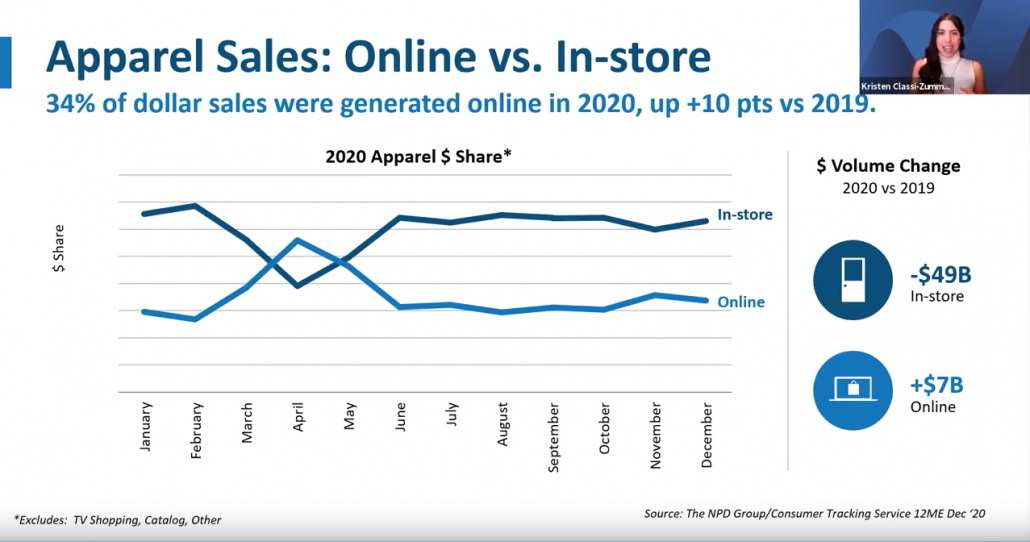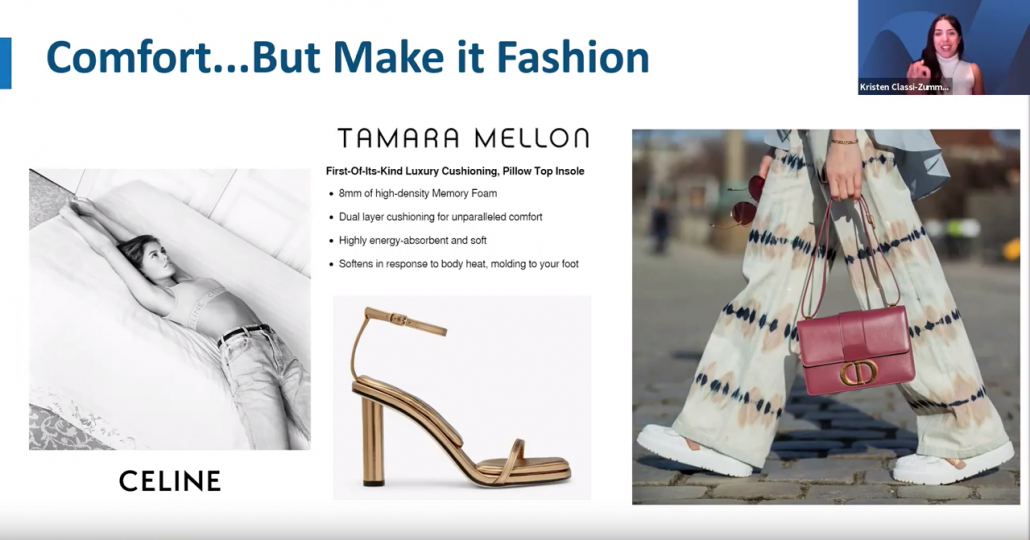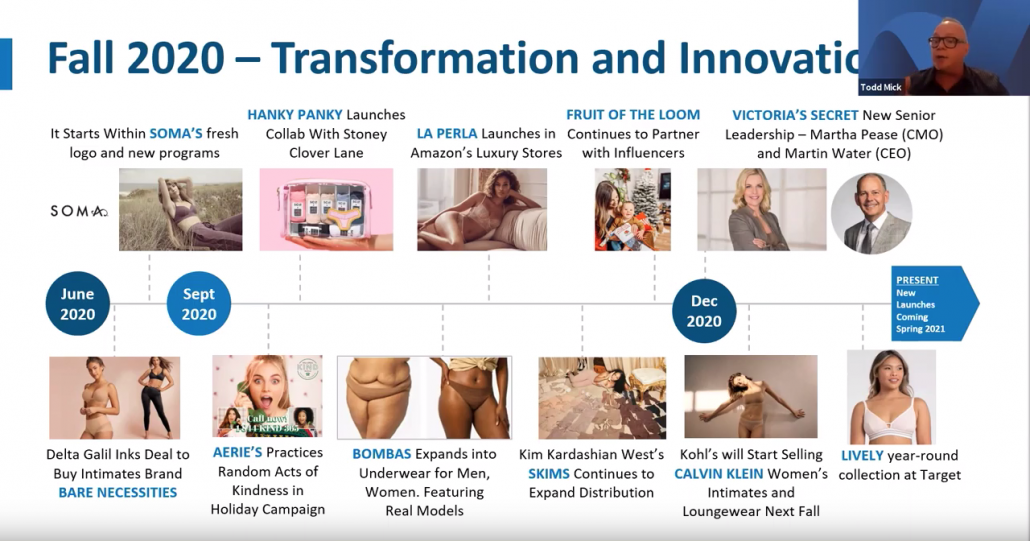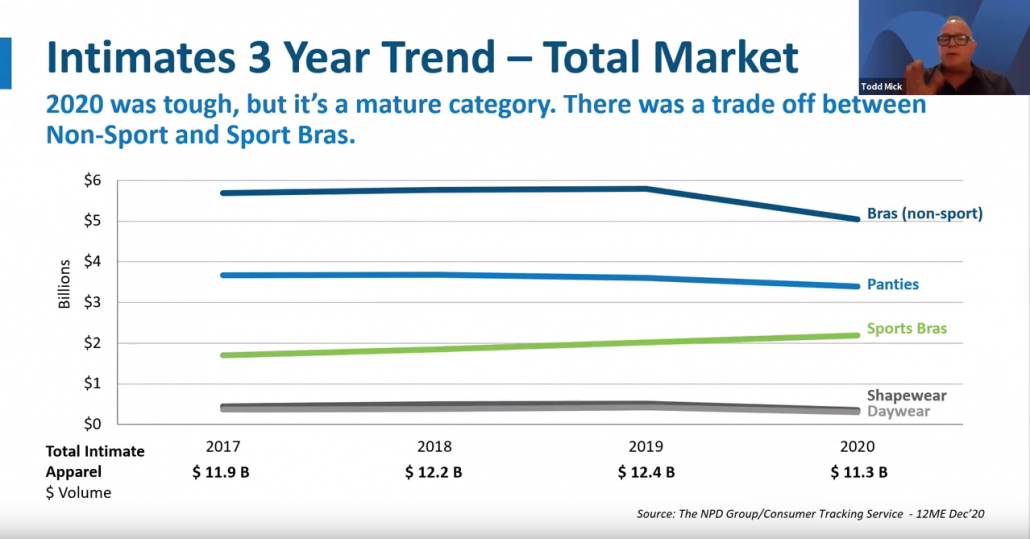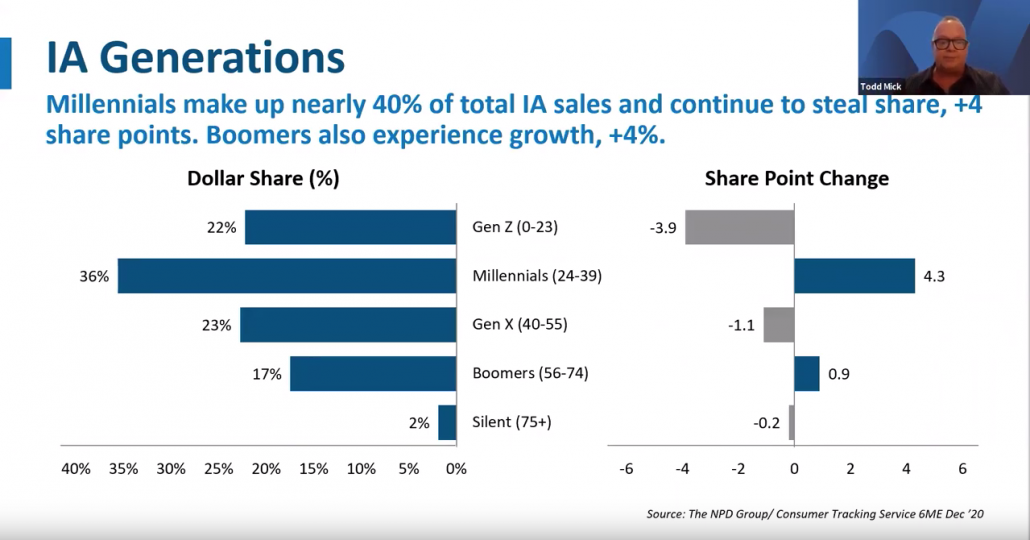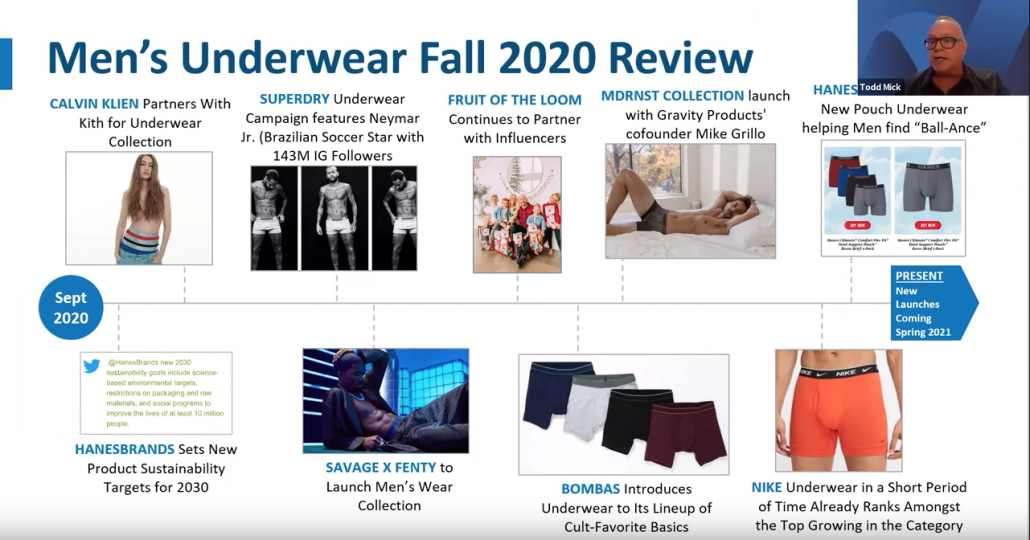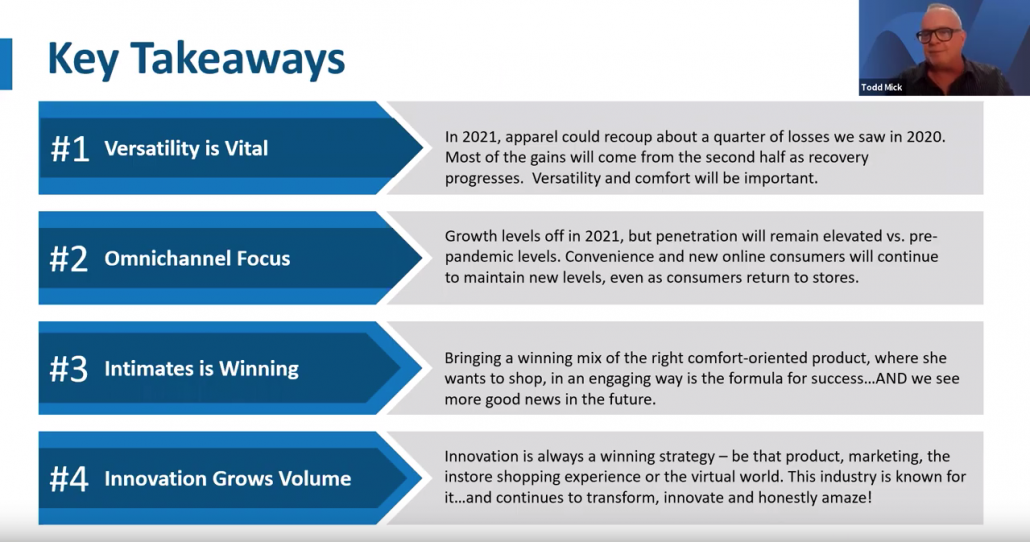On Tuesday, March 30th 2021, NPD Industry Analysts shared how the apparel and intimates consumer has evolved, how the Intimate Apparel Industry fared during 2020, and how the brands and retailers that won innovated and transformed. NPD is a global market research company that spans across various industry and uses data, analytics, and industry expertise to guide clients with the tools they need to measure, predict, and improve category performance. We thank Todd Mick and Kristen Classi-Zummo for sharing their knowledge with The Underfashion Club!
The NPD experts discussed intimate apparel industry performance in 2020 and future indicators of where we’re heading. According to a poll response, 30% of people have purchased underwear/panties, 30% bought underwire bras, and 20% purchased pajamas and loungewear.
Total apparel declined $42 billion in 2020, setting us back closer to the market size of 2010. Apparel sales were down 19%, being comprised of 53% in women’s, 31% in men’s, and 16% in kids’ apparel in dollars. Kids’ clothing was impacted the least since children continue to grow and need new basics.
In-store spending declined 30%. Many fitting rooms are still off-limits, removing one of the main benefits of in-store shopping. Online and warehouse clubs gained apparel buyers who shop more frequently, but spend less per trip. This could be due to ease of access. Specialty stores and national chains lost 10% or buyers, but buyers are spending more per purchase when it comes to apparel. They maximize their in-store trips.
The NPD experts discussed intimate apparel industry performance in 2020 and future indicators of where we are heading. According to a poll response, 30% of people have purchased underwear/panties, 30% bought underwire bras, and 20% purchased pajamas and loungewear.
Total apparel declined $42 billion in 2020, setting us back closer to the market size of 2010. Apparel sales were down 19%, being comprised of 53% in women’s, 31% in men’s, and 16% in kids’ apparel in dollars. Kids’ clothing was impacted the least since children continue to grow and need new basics.
In-store spending declined 30%. Many fitting rooms are still off-limits, removing one of the main benefits of in-store shopping. Online and warehouse clubs gained apparel buyers who shop more frequently, but spend less per trip. This could be due to ease of access. Specialty stores and national chains lost 10% of buyers, but buyers are spending more per purchase when it comes to apparel. They maximize their in-store trips.
The way consumers are spending is changing as well. “Buy now, pay later” options have been heavily promoted as a purchasing incentive aside from discounts. Staying home and looking to combat stress inspired a quest for comfort among consumers. Candle sales increased by 21%, electric blankets and slipper sales were up 60%, and sweatpants sales were up 13%. The quest for comfort is driven by four key themes: working from home, stress relief, health & wellness, and casualization.
When buying clothing, comfort is the #1 factor, which has almost double the influence of price. Consumers who buy activewear spent 18% more per purchase than non-activewear buyers. Non-activewear buyers spent 10% less compared to 2019. Activewear can be worn anywhere and is seen as an investment for wellness.
40% of current workers may continue working from home more after COVID-19, making versatility more important than ever. Lives are not as segmented as they once were, with work and personal lives blending into the day. Apparel and undergarments reflects this. While a third of consumers don’t miss getting dressed up, over half do. A fashion moment is coming, but it will be one rooted in comfort.
Swim categories performed better than expected during the summer of 2020. It’s expected to pick back up even more in 2021. A third of consumers report intending to return to pre-pandemic travel behaviors by the end of the summer.
The intimates industry has performed quite well throughout the pandemic with innovation and transformation. Data shows that while women’s apparel sales decreased by 15%, intimate apparel only decreased by 2%. Intimates companies sprang to action in Fall 2020, keeping customers excited and engaged by what was happening in the fashion world with action towards inclusion and social responsibility.
What’s driving spending in the intimates space? First, is where you sell. Mass retailers were winning by offering multi-channel availability so consumers can stock up on necessities as well as apparel in the same space. Online availability also proved important, accounting for 35% of intimate apparel sales.
Second, is all about comfort. It’s all about meeting the customer where she is in her new stay-at-home lifestyle. Delivering comfort and evolving with the adjustment back to “normal” without sacrificing comfort will keep brands relevant to consumers.
Third, having effective online customer service is imperative. Finding innovative ways to ensure your customer understands the product and how well it will fit without physical contact encourages spending in intimates.
And last, how you speak to your customer is key. Showing inclusivity and empowering women among all demographics acknowledges the importance of social awareness. Body positivity and size inclusivity was one of the top factors when deciding to make a purchase among today’s fashion consumer.
In 2020, the intimates business took a dip of $1.1 billion with total sales of $11.3 billion. In Fall 2020, sports bras grew by 14% while non-sports bra sales were down 4%. Panties sales were down 1%. Mass and direct sales benefited the most from the pandemic. Online intimates sales peaked by 46% in Q2’20, then plateaued down to 35-34%. This shows a rapid acceleration in the desire among consumers to shop online.
If a brand was available in stores open during the pandemic, their business would do well. Brands that showcased more diversity and size inclusivity in an effort to relate to the ethically-conscious consumer saw increased success.
High-performing brands have been focusing on millennials as they make up 36% of intimates sales and are growing. Boomers also embraced online shopping, making up 17% of sales.
Intimates and wellness is for everyone, regardless of generation. Wellness partnerships and acquisitions continue to surface over a variety of industries/categories that have broad appeal. Companies have purchased fitness startups, launched wellness collections, and added vitamin shops to their stores to promote self-care during the pandemic.
Sleepwear has been growing over three consecutive years, from $4.4 billion in 2017 to $5.6 billion in 2020. Brands have coordinated regular apparel pieces with sleepwear garments to create complete outfits for the stay-at-home lifestyle.
Men’s underwear performed quite well in 2020. Partnerships, new collections, and body positivity in men’s underwear shows evolution in the industry. Innovation in the construction of men’s underwear and showcasing a variety of bodies as well as gender fluidity is evidence of the intimates industries’ dedication to supporting comfort in their customers for a broader consumer segment. While men’s apparel sales were down 12%, men’s underwear grew by 2%.
The top 10 apparel classes show that “power comfort categories” are winning. The majority of dollar gains came from sweatshirts, underwear, and sleepwear. Interestingly, sleepwear is continuing to do well post-holiday as people are wearing it for lounge. Men’s underwear fared well as a must-have category, relatively unimpacted compared to total apparel.
Where you sell, comfort and innovation, and value all were key to what drove spending in 2020. Mass retail spaces and online stores were the main points of sales in men’s underwear. Creating comfort features that allow him the versatility to work, live and play in the same pair were the highlight in innovation. Value in the economic pandemic also played a role, such as higher pack counts and lower prices.
Mass merchants hold the largest share of sales, but declined as E-commerce and warehouse clubs gained business. Millennials make up 40% of underwear sales, growing by 12% over the prior year and Boomers, making up 13% of sales, grew by 31%. Almost 60% of men’s underwear is bought for personal use and 31% was purchased as a gift from women, showing an increase of 18%.
NPD’s future forecasting analysis predicts that in 2021, intimate apparel could recoup about a quarter of the losses experienced in 2020, primarily in the second half of the year. Comfort will continue to play a big role as quarantine routines may become more permanent. E-commerce growth will level off, not returning to pre-pandemic levels because of the convenience and comfort of online shopping.
Intimates are thriving. Understanding the customer’s lifestyle and bringing convenience to shopping in an engaging way is paving the way to the industry’s growth and success. Innovation is a winning strategy and this industry is built on it in products, marketing, and more. The intimate apparel industry will continue to amaze!
“Basics maintain volume. Innovation grows volume.”
– Marshall Cohen


